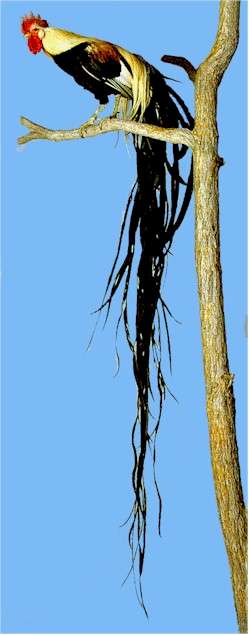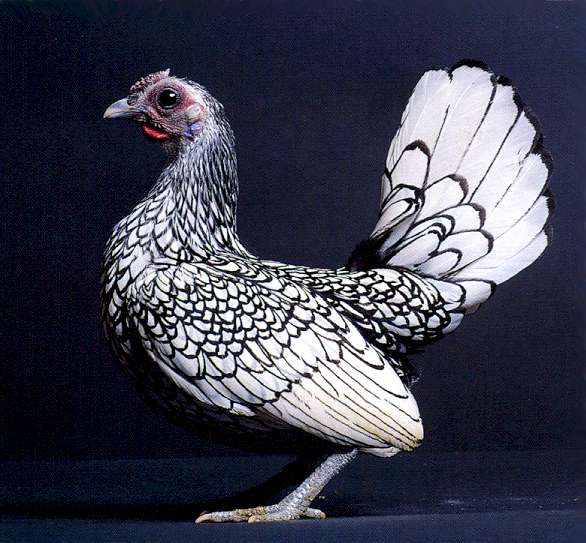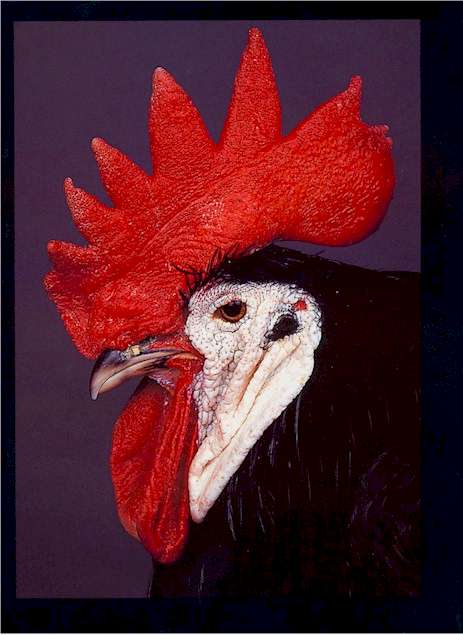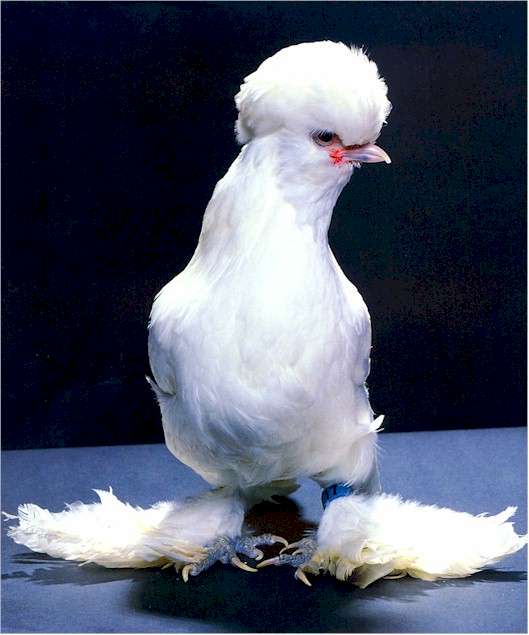The Beak of Perfection
You Elegant FowlHere are 4 commandments that those of us that breed and raise standard bred poultry need to live by: Thou shall not keep more birds than you have facilities for - Boisfort Exhibition Poultry www.poultrysupply.com
Rising from the Ashes: the PhoenixThis variety of chicken has required 400 years of breeding to achieve their long tail feathers - which can reach 20 - 30 feet.
Phoenix
Sebright DwarvesFrom Britain comes a variety once very popular in the UK whose genes are used to pass "lacing" onto many other show birds. Sebright bantams are among the most eye-catching birds in the world of poultry in both their varieties. The Silver Sebright is a white bird with black lacing on all its feathers. The Gold has black lacing on a base color of golden brown. The 26 ounce rooster outweighs the hen by 4 ounces. The birds carry a rose comb and the males must be "hen-feathered." The Sebright is one of the true bantams. That means there is no standard (large) version of the breed. The breed was developed by Sir John Sebright early in the 1800s and has the distinction of being the only breed of chicken named for an individual.
Sebright Silver hen
SilkiesThe Silkie is the only breed with black pigmented skin. The feathers are without the usual forms of webs, that is, there is a lack of adhesion of the barbs to one another which gives the appearance of down or silky hair, hence the name silken or Silkie. Another distinguishing feature is turquoise blue ear lobes. These birds originated in China, found there by Marco Polo in 1298. (Marco Polo thought silkies were covered with wool rather than feathers, hence the name.) In America, the breed ranks in the first 15 breeds in popularity. They are characterised as: active, bold, silky and fluffy. Male and female silkies are sexually mature at about five months of age. Their eggs are a brownish colour and a female lays between 90 and 120 eggs per year. All hens like to lay their eggs in a nest that is in a quiet, semi-darkened, well-prepared place with good, clean nesting material. The hen takes about two hours from sitting to leaving the nest. Most hens prefer to brood in the same place where they are accustomed to laying eggs. Eggs hatch in about 21 days. The chicks are covered with soft down at birth. During the first 24 hours after hatching, the chicks consume the remainder of the yolk.
Silkie Non-bearded Black
Spanish WhitefaceComing from Spain, this breed arrived in the US via the Caribbean Islands. Spanish are the oldest breed of chickens existent in the US today. At one time known as "The Fowls of Seville", they were very popular in the South during the Colonial period. The large area of snow white skin surrounding the face and wattles makes this breed unique. Actually this is an over developed earlobe. Its color offers a marked contrast with the black plumage and the red comb and wattles. They are considered non-broody and hold their feathers close to their body contours. Spanish are active and noisy. Many individuals are below recommended weight, and at this time, most of the population is highly inbred. They are prized for large white eggs.
Spanish White-face
SultanSultans come from Turkey. They were bred from Polish stock and are strictly an ornamental fowl of very distinctive appearance. They have a large crest, muffs and beard, together with profuse feathering of the feet and legs.
Sultan White hen Source: a fascinating coffee-table-type book called Extraordinary Chickens by Stephen Green-Armytage. The book had dozens of pictures of - well - extraordinary chickens. For more pages of photos of unusual chickens, please see This Doesn't Fly, Something to Crow About and Beauty Parlour Chicks (the three pages preceding this one). Some information on these three pages was taken from ansi.okstate.edu/poultry/chickens and honoluluzoo.org/bantam_chicken.htm.
For more on animals, including reptiles, crustaceans, arachnids, insects, fish, birds, pets, livestock, rodents, bears, primates, whales and Wellington's waterfront, click "Up" below to
take you to the Table of Contents for this Animals section. |
 Animals
Animals Animation
Animation Art of Playing Cards
Art of Playing Cards Drugs
Drugs Education
Education Environment
Environment Flying
Flying History
History Humour
Humour Immigration
Immigration Info/Tech
Info/Tech Intellectual/Entertaining
Intellectual/Entertaining Lifestyles
Lifestyles Men
Men Money/Politics/Law
Money/Politics/Law New Jersey
New Jersey Odds and Oddities
Odds and Oddities Older & Under
Older & Under Photography
Photography Prisons
Prisons Relationships
Relationships Science
Science Social/Cultural
Social/Cultural Terrorism
Terrorism Wellington
Wellington Working
Working Zero Return Investment
Zero Return Investment



